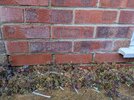- Joined
- 29 Oct 2024
- Messages
- 7
- Reaction score
- 1
- Country

Hi, new here but hoping someone can help. Opened up the cavity on one side of our conservatory door to inspect some bad damp that we had there. Pulled out all the old fibreglass insulation which was soaked through and home to an ants nest, but now I need to decide whether to insulate again or keep the cavity open, and how to install a cavity closer with the door in place. The cavity also isn't one width all the way up so it would be tricky to cut the cavity closer to size to get a good fit. It was previously just plasterboard and plaster.
We've determined that the eroded mortar to the exterior is most likely the cause of the damp, and I will be repointing before sealing the cavity back up to make sure the issue is resolved.
Please see photos below:

Open cavity.

Ext. view.

Damage to mortar towards top of wall just below window sill.

Gap formed between conservatory brickwork and garage. Clearly wasn't tied in properly when the conservatory was added. Do I retrofit wall ties or just repair the mortar??

My cat wondering why on Earth I'm dragging fluff out of the walls. I've clearly gone mad and he looks concerned about it.
Thank you in advance for any help!
We've determined that the eroded mortar to the exterior is most likely the cause of the damp, and I will be repointing before sealing the cavity back up to make sure the issue is resolved.
Please see photos below:
Open cavity.
Ext. view.
Damage to mortar towards top of wall just below window sill.
Gap formed between conservatory brickwork and garage. Clearly wasn't tied in properly when the conservatory was added. Do I retrofit wall ties or just repair the mortar??
My cat wondering why on Earth I'm dragging fluff out of the walls. I've clearly gone mad and he looks concerned about it.
Thank you in advance for any help!

